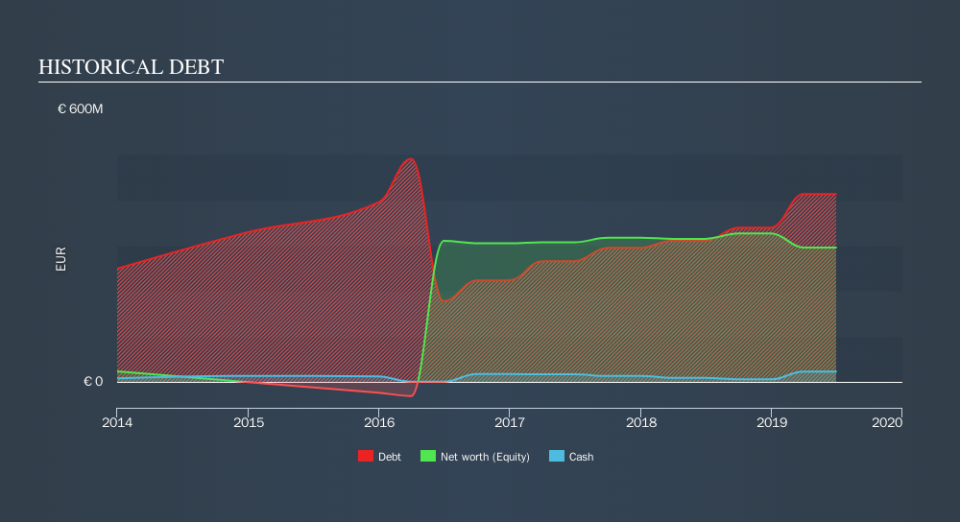Is Basic-Fit (AMS:BFIT) Using Too Much Debt?

Some say volatility, rather than debt, is the best way to think about risk as an investor, but Warren Buffett famously said that 'Volatility is far from synonymous with risk.' When we think about how risky a company is, we always like to look at its use of debt, since debt overload can lead to ruin. As with many other companies Basic-Fit N.V. (AMS:BFIT) makes use of debt. But the more important question is: how much risk is that debt creating?
Why Does Debt Bring Risk?
Generally speaking, debt only becomes a real problem when a company can't easily pay it off, either by raising capital or with its own cash flow. Part and parcel of capitalism is the process of 'creative destruction' where failed businesses are mercilessly liquidated by their bankers. However, a more common (but still painful) scenario is that it has to raise new equity capital at a low price, thus permanently diluting shareholders. Of course, plenty of companies use debt to fund growth, without any negative consequences. When we examine debt levels, we first consider both cash and debt levels, together.
See our latest analysis for Basic-Fit
What Is Basic-Fit's Debt?
You can click the graphic below for the historical numbers, but it shows that as of June 2019 Basic-Fit had €413.7m of debt, an increase on €311.1m, over one year. On the flip side, it has €23.0m in cash leading to net debt of about €390.7m.
How Healthy Is Basic-Fit's Balance Sheet?
According to the last reported balance sheet, Basic-Fit had liabilities of €228.7m due within 12 months, and liabilities of €1.16b due beyond 12 months. On the other hand, it had cash of €23.0m and €29.2m worth of receivables due within a year. So its liabilities outweigh the sum of its cash and (near-term) receivables by €1.34b.
This deficit is considerable relative to its market capitalization of €1.61b, so it does suggest shareholders should keep an eye on Basic-Fit's use of debt. This suggests shareholders would heavily diluted if the company needed to shore up its balance sheet in a hurry.
We use two main ratios to inform us about debt levels relative to earnings. The first is net debt divided by earnings before interest, tax, depreciation, and amortization (EBITDA), while the second is how many times its earnings before interest and tax (EBIT) covers its interest expense (or its interest cover, for short). This way, we consider both the absolute quantum of the debt, as well as the interest rates paid on it.
Basic-Fit has a debt to EBITDA ratio of 3.0 and its EBIT covered its interest expense 2.5 times. This suggests that while the debt levels are significant, we'd stop short of calling them problematic. The good news is that Basic-Fit improved its EBIT by 5.6% over the last twelve years, thus gradually reducing its debt levels relative to its earnings. There's no doubt that we learn most about debt from the balance sheet. But it is future earnings, more than anything, that will determine Basic-Fit's ability to maintain a healthy balance sheet going forward. So if you want to see what the professionals think, you might find this free report on analyst profit forecasts to be interesting.
Finally, a company can only pay off debt with cold hard cash, not accounting profits. So the logical step is to look at the proportion of that EBIT that is matched by actual free cash flow. Over the last three years, Basic-Fit saw substantial negative free cash flow, in total. While investors are no doubt expecting a reversal of that situation in due course, it clearly does mean its use of debt is more risky.
Our View
We'd go so far as to say Basic-Fit's conversion of EBIT to free cash flow was disappointing. But at least its EBIT growth rate is not so bad. We're quite clear that we consider Basic-Fit to be really rather risky, as a result of its balance sheet health. For this reason we're pretty cautious about the stock, and we think shareholders should keep a close eye on its liquidity. Over time, share prices tend to follow earnings per share, so if you're interested in Basic-Fit, you may well want to click here to check an interactive graph of its earnings per share history.
When all is said and done, sometimes its easier to focus on companies that don't even need debt. Readers can access a list of growth stocks with zero net debt 100% free, right now.
We aim to bring you long-term focused research analysis driven by fundamental data. Note that our analysis may not factor in the latest price-sensitive company announcements or qualitative material.
If you spot an error that warrants correction, please contact the editor at editorial-team@simplywallst.com. This article by Simply Wall St is general in nature. It does not constitute a recommendation to buy or sell any stock, and does not take account of your objectives, or your financial situation. Simply Wall St has no position in the stocks mentioned. Thank you for reading.

